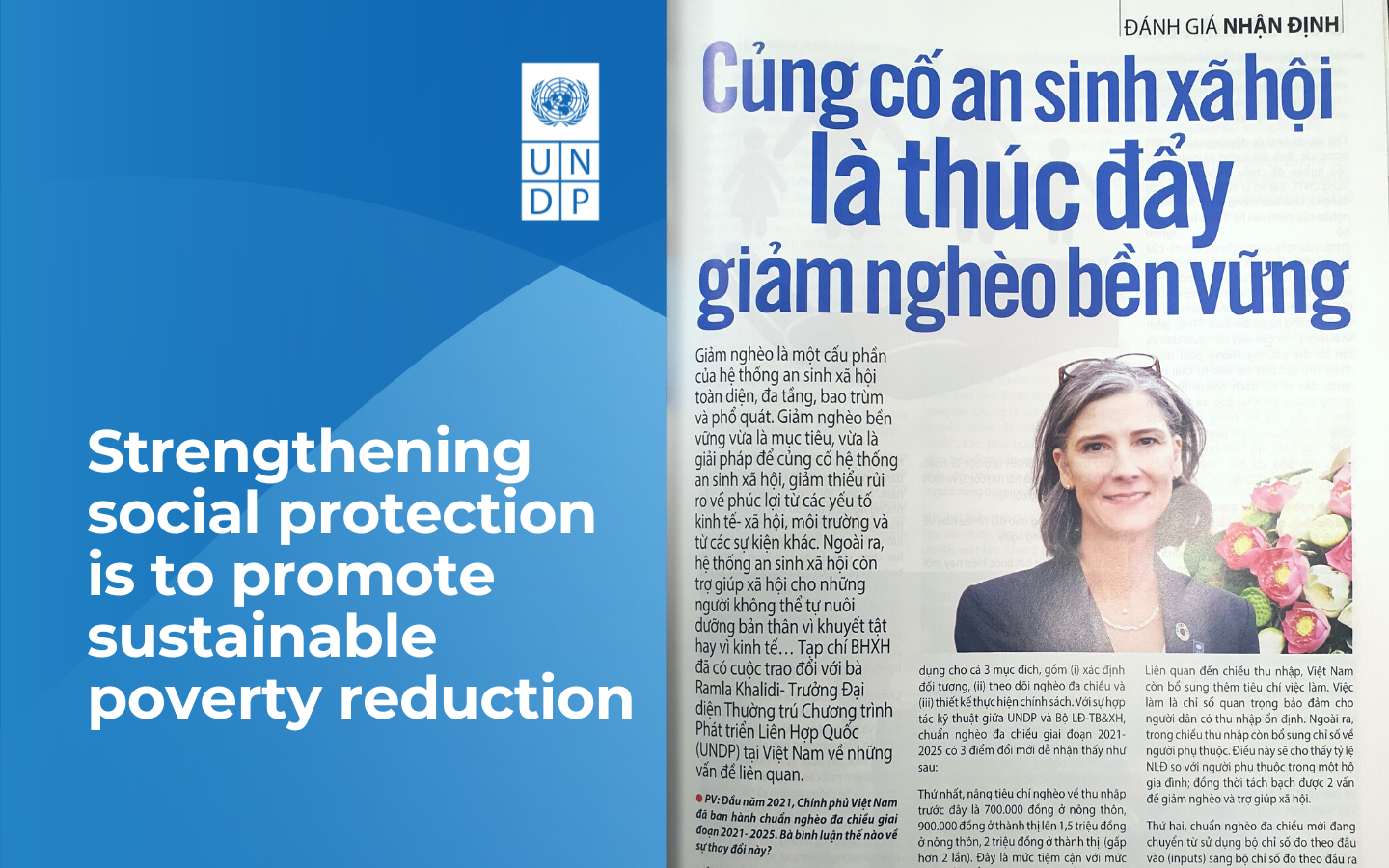Interview by Ms. Ramla Khalidi, UNDP Resident Representative in Viet Nam
Strengthening social protection is to promote sustainable poverty reduction
December 31, 2022

Social Insurance Magazine
As published in Social Insurance Magazine in December 2022
What are the linkages between the social protection system (SPS) and sustainable poverty reduction?
Poverty reduction is both a component in and an outcome of a comprehensive, multi-layered, inclusive, universal, rights-based, gender sensitive and shock-responsive social protection system (SPS). A comprehensive social protection system minimizes risks to well-being from social, environmental and economic factors and from normal life events such as illness, aging and the costs of raising children. It also provides help to people who are unable to provide for themselves because of disability and structural economic factors.
Could you please share innovative ideas in the new multidimensional poverty line for the 2021 - 2025 period?
Compared to the international MDP measurement, apart from the basic social services dimensions, the Vietnamese MDP measurement includes an income dimension. Additionally, Viet Nam's MDP measurement is used for the triple purposes of (i) targeting, (ii) monitoring and (iii) policy formulation and implementation. With technical cooperation between UNDP and MOLISA, the multidimensional poverty line for the period of 2021 - 2025 has 3 big innovations, as follows.
First, increasing the minimum income threshold from 700,000 VND in rural areas, 900,000 VND in urban areas (in 2015 – 2020 period) to 1.5 million VND in rural areas, 2 million VND in urban areas (more than 2 times) in 2021 – 2025 period. This increase is remarkable, making an additional 10 million people eligible for government support on poverty reduction and social protection. This is an important and timely solution in the context of the COVID pandemic that has pushed millions of vulnerable households back into poverty.
Regarding the income dimension, an employment indicator has also been added which is important for people to ensure stable incomes. Under the income dimension, the dependent indicator is also added. This measures the ratio of working members and non-working members in a household. As a result, it generates disaggregated data for addressing the two separate issues of poverty reduction and social assistance.
Second, the new multi-dimensional poverty line is gradually shifting from measuring inputs to outcome indicators. For example, in health care, in the past we only measured the percentage of people who were provided with health insurance cards, regardless of whether the card holders used them or the quality of health care services received. But the new MDP line uses nutrition. And in education the percentage of children entering school at the right age has been added to the school enrolment rate as a outcome measure.
Third, promoting the application of information technology and digital transformation in self-registration and management of MDP data. Through IT application, anyone can self-register or enter information and data about their poverty situation into the Government’s self-registration and management of MDP (via this portal http://dangky.giamngheo.gov.vn). The commune/ward authorities can verify the information on the online portal. This digital system significantly reduces administrative procedures; lessens the volume of paper-based workload; and saves travelling costs for local people and officials. With self-declaration approach, participants are more responsible for the information declared and demonstrate their rights to benefit from the related poverty reduction policies and programs in a more timely manner, especially in the rapidly changing contexts of COVID-19.
How do you assess the current social protection system and the current social insurance policy network?
In my opinion, a comprehensive social protection system should be designed with multiple layers, performing all four functions of the 4Ps, namely Promotion, Prevention, Provision and Protection. With technical assistance from UNDP and other UN agencies, Viet Nam's social protection system has also been designed with multiple layers, including four pillars (i) Employment, income and poverty reduction - Promotion; (ii) Social insurance - Prevention; (iii) Social assistance-Provision and (iv) Basic social services - Protection.
In essence, Viet Nam's social protection system is multi-layered, performing all four functions, specifically the promotion function of the first pillar on employment, minimum income and poverty reduction; prevention of social insurance; provision of social assistance and protection of people through the basic social services system. Thus, Viet Nam's social protection system is multi-layered and quite comprehensive. Individuals and households that do not achieve a minimum level of income through employment (pillar 1) will receive support through social insurance (pillar 2) or social assistance schemes (pillar 3).
I would like to focus more on the second “P” – Prevention (pillar 2).
In reality compulsory social insurance schemes reach only 32% of the working population while the coverage of voluntary insurance is very low, only 2.1%. Such low coverage reveals that about 37 million working people are not covered by social insurance programs. This will certainly have a negative effect in the long term.
Viet Nam's social insurance network has many advantages, in terms of impact and flexibility.
First, people participating in social insurance schemes are supported by the Government, with lower income households receiving more support. The government contributes 30% for poor households, 25% for the near-poor, and 10% for other participants.
Second, contribution levels, times, and modalities are very flexible. People can choose the level of contribution that is suited to their financial capacity. The minimum level is equal to the poverty line. The payment time is flexible. In the past, twenty years of contributions were required to be eligible for a pension. Resolution 28, however, calls for “gradually reducing the minimum number of years of payment of social insurance contributions to 15 years, towards 10 years” (R28, 2018, page 4). Therefore, people at the age of 50 can still start participating in social insurance schemes and benefit from the pensions when they are 60 years old. Moreover, people have the right to choose to switch from the compulsory social insurance scheme to voluntary social insurance. However, the level of benefits will depend on the time and level of contribution based on the principle of ‘pay – benefit’ of social insurance schemes. Despite low levels of benefits, the pension will be a monthly cash transfer and that is very important for every citizen when they get old and If they are ill.
Therefore, we encourage everyone to join the social insurance system (both compulsory and voluntary) and should not make one-time withdrawals. If many people decide to withdraw their social insurance contributions once or the SI coverage is low, it will cause an imbalance between the two financing sources for social protection system, including the 'pay - benefit' source contributed by SI participants (under the pillar of social insurance) with the 'don't pay but benefit' which is financed by the state budget for social insurance beneficiaries (under the social assistance pillar). If the 'pay-benefit' component is smaller, more people will not have a pension when they get old, then the Government will have to use the State funding which is budgeted for the social assistance pillar to cover the non-social pension people. Thus, the level of benefit and coverage of social assistance is definitely affected.
How important is the health insurance policy in the social protection system?
Health insurance (HI) is one of four social insurance policies, i.e., compulsory, voluntary, unemployment and health insurance. Unlike social insurance, which applies the principle of “pay – benefit/go”, HI follows the principle of “sharing”. That is, HI is paid by many people, but few benefit from it. Everyone wants to enjoy SI, but no-one looks forward to using HI cards. Because no one wants to get sick. However, in fact, we cannot avoid being sick sometime during our lifetime.
In terms of HI card holder’s benefits, health insurance is like a protective shield when people get sick. A HI card holder can be financed from 80% - 100% of health care services if he goes to the registered hospital/health care center, and from 40% - 60% if he goes to the non-registered one. You don’t recognize the importance of HI when you are healthy and wealthy. Only when you are sick and poor, is "the most expensive bed in the world in the hospital". Therefore, the slogan of health insurance is "Pay when you are healthy, benefit when you are ill".
In terms of social benefits, health insurance and/or social insurance is a sharing mechanism among citizens and between the Government and citizens, this leads to more social justice. More importantly, the second net (SI pillar) is to minimize people to fall into the last net (social assistance) of the social protection system.
In your opinion, what are the solutions for expanding social insurance coverage?
We recommend 3 key solutions for expanding social insurance coverage:
First, strengthen communication activities extensively and intensively. Based on Bloom's Taxonomy, the cognitive domain is broken into the six levels of objectives, i.e., Remember, Understand, Apply, Analyze, Evaluate, and Create. Our communication program just reaches the first level. Many people don’t know and understand the importance of SI schemes. It is crucial to strengthen communication campaigns get more people to understand, believe in and participate in—and persuade their relatives to enroll in—SI schemes.
Second, provide alternative solutions to provide financial support for those who withdraw one-time social insurance. We may provide preferential loans to help them solve their temporary problems. In other cases, they are allowed to withdraw only 8% of their direct contribution and hold 14% of contribution paid by the employers in order to keep them in the SI system.
Third, promote the application of IT. As it provides SI contributors with timely and accurate information about their ‘pay-benefit’ situation. Therefore, it helps build people’s trust in the system and willingness to join and encourage other people to join as well.
Viet Nam's social protection system has been designed with multi-layers, performing quite comprehensively and effectively all four functions of 4Ps, i.e., Promotion, Prevention, Provision and Protection. In case, a person falls off the upper layer, he will be supported by the lower layer.

 Locations
Locations


